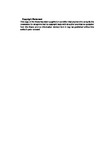Determinants of Capital Structure: the case of MENA countries
| dc.contributor.supervisor | EL-MASRY, Ahmed | |
| dc.contributor.author | ALBARRAK, Mansour Saleh | |
| dc.contributor.other | Plymouth Business School | en_US |
| dc.date.accessioned | 2015-11-05T15:56:07Z | |
| dc.date.available | 2015-11-05T15:56:07Z | |
| dc.date.issued | 2015 | |
| dc.identifier | 10358506 | en_US |
| dc.identifier.uri | http://hdl.handle.net/10026.1/3764 | |
| dc.description.abstract |
This thesis examines the determinants of capital structure in the MENA coun- tries. The main interest is to investigate both financial firms specially banks and non-financial firms. This study test the main theories of capital structure, namely: trade off theory and pecking order theory. The countries included in this thesis are Saudi Arabia, United Arab Emirates (Include both Abo-Dhabi and Dubai stock indexes), Bahrain, Qatar, Kuwait, Oman, Egypt, Morocco, Tunisia, Palestine and Jor- dan. The characteristics it covers as suggested by previous literature are tangibility, profitability, risk, debt tax shield, growth, dividends,size, cash flow and liquidity. It will also investigate the effect of the industry, credit rating and ownership structure on the capital structure This study also investigates the determinants of capital structure in Islamic and conventional banks. This is one of the first attempts to empirically examine the determinants of capital structure in Islamic and conventional banks in general and in MENA countries in particular. This study fills the gap in this important area of research and can provide a base for future research on capital structure in Islamic banks. This thesis use different models to test the capital structure and these are Panel data models (OLS, Fixed, and Random); Tobit and Dynamical model (Arellano-Bover Blundell-Bond), Structural Equation Modeling (SEM) and Generalised Regression Neural Networks (GRNN). The results suggest that the three methods used in this study lead to similar re- sults with a few exceptions in some countries. This thesis finds that the relation between leverage and the determinants of capital structure is different when using the market or the book leverage. It also finds that the determinants of capital struc- ture between the MENA countries are different. For example, profitability attribute relation with leverage follow the trade-off theory in some countries and follow the picking order theory in other countries. Also, liquidity is significant in all the countries in the sample and have a negative relation to leverage. In addition, tangibility is found to have a mixed results with some countries following the trade-off theory and other countries which follow the trade-off theory but overall it is a key determinant of capital structure. Additionally, the findings show that although that the majority of firms in the MENA countries don’t pay dividends the relation between the long term debt and leverage is negative in all the countries in the sample. The growth opportunities have a negative relation in Bahrain, Egypt, Jordan, Kuwait, Morocco, Palestine, Qatar and Tunisia but positive in rest of the countries. The cash flow attribute have a negative relation with leverage in all the countries in the sample except Saudi Arabia and Qatar when using the short and long term debt. Furthermore, the ownership variable is expected to have a negative relation when the ultimate owner is an institution. The results show that overall when there is an ultimate owner the leverage will have a negative relation. Suggesting that ultimate owners will force managers to keep a low debt in firms capital structure. This PhD also attempt to investigate the capital structure in banks within the MENA countries. A special focus is on the differences between the Islamic banks and conventional banks capital structure. First, the findings show that the banks follow the same determinants of capital structure as non-financial firms and that regulations are not the main determinant of capital structure in banks. Then, This study show that there is a difference in capital structure of Islamic banks in com- parison with conventional banks. The findings for the dividends variable show that Islamic banks do not follow the pecking order theory but conventional banks don’t. The results of the size variable show that when Islamic banks are large they use less debt in their capital structure. Growth variable show mixed results depending on the use of book or market leverage. Ownership structure show that when there is an ultimate owner leverage increase which is the reverse of the relation in the non-financial firms. The age variable is negative in relation to the book leverage and positive with the market leverage. Also, credit rating relation is different between the two banks, as it is positive with the conventional banks and negative with Islamic banks. Therefore, this study conclude that the main capital structure theories are applicable to MENA countries. Also indicate that Islamic banks have a different capital structure to conventional banks. | en_US |
| dc.description.sponsorship | Saudi Electronic University | en_US |
| dc.language.iso | en | en_US |
| dc.publisher | Plymouth University | en_US |
| dc.subject | Capital Structure | en_US |
| dc.subject | Trade-off Theory | en_US |
| dc.subject | Pecking Order Theory | en_US |
| dc.subject | MENA | en_US |
| dc.subject | SEM | en_US |
| dc.subject | GRNN | en_US |
| dc.title | Determinants of Capital Structure: the case of MENA countries | en_US |
| dc.type | Thesis | |
| plymouth.version | Full version | en_US |
| dc.identifier.doi | http://dx.doi.org/10.24382/4286 | |
| dc.identifier.doi | http://dx.doi.org/10.24382/4286 |
Files in this item
This item appears in the following Collection(s)
-
01 Research Theses Main Collection
Research Theses Main


